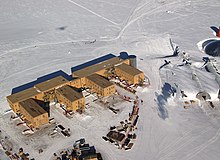Antarctic
Climate change in Antarctica is particularly important because the melting of the Antarctic ice sheet has a high potential to add to the global sea level rise.
Further, this melting also disrupts the flow of Southern Ocean overturning circulation, which would have significant effects on the local climate and marine ecosystem functioning.There is no permanent country in Antarctica .
[15][16]) To protect the area, all Antarctic ships over 500 tonnes are subject to mandatory regulations under the Polar Code, adopted by the International Maritime Organization (in force since 1 January 2017).
[21] The fresh, 1100–1500 billion tons (GT) per year of meltwater from the ice dilutes the saline Antarctic bottom water,[29][30] weakening the lower cell of the Southern Ocean overturning circulation (SOOC).
[25]: 1240 According to some research, a full collapse of the SOOC may occur at between 1.7 °C (3.1 °F) and 3 °C (5.4 °F) of global warming,[31] although the full effects are expected to occur over multiple centuries; these include less precipitation in the Southern Hemisphere but more in the Northern Hemisphere, an eventual decline of fisheries in the Southern Ocean and a potential collapse of certain marine ecosystems.
[34] The first recorded sighting of Antarctica is credited to the Spaniard Gabriel de Castilla, who reported seeing distant southern snow-capped mountains in 1603.
The first Antarctic land discovered was the island of South Georgia, visited by the English merchant Anthony de la Roché in 1675.
Although such myths and speculation about a Terra Australis ("Southern Land") date back to antiquity, the first confirmed sighting of the continent of Antarctica is commonly accepted to have occurred in 1820 by the Russian expedition of Fabian Gottlieb von Bellingshausen and Mikhail Lazarev on Vostok and Mirny.
The Antarctic region had no indigenous population when first discovered, and its present inhabitants comprise a few thousand transient scientific and other personnel working on tours of duty at the several dozen research stations maintained by various countries.
In December 2009, the growth of tourism, with consequences for both the ecology and the safety of the travellers in its great and remote wilderness, was noted at a conference in New Zealand by experts from signatories to the Antarctic Treaty.












